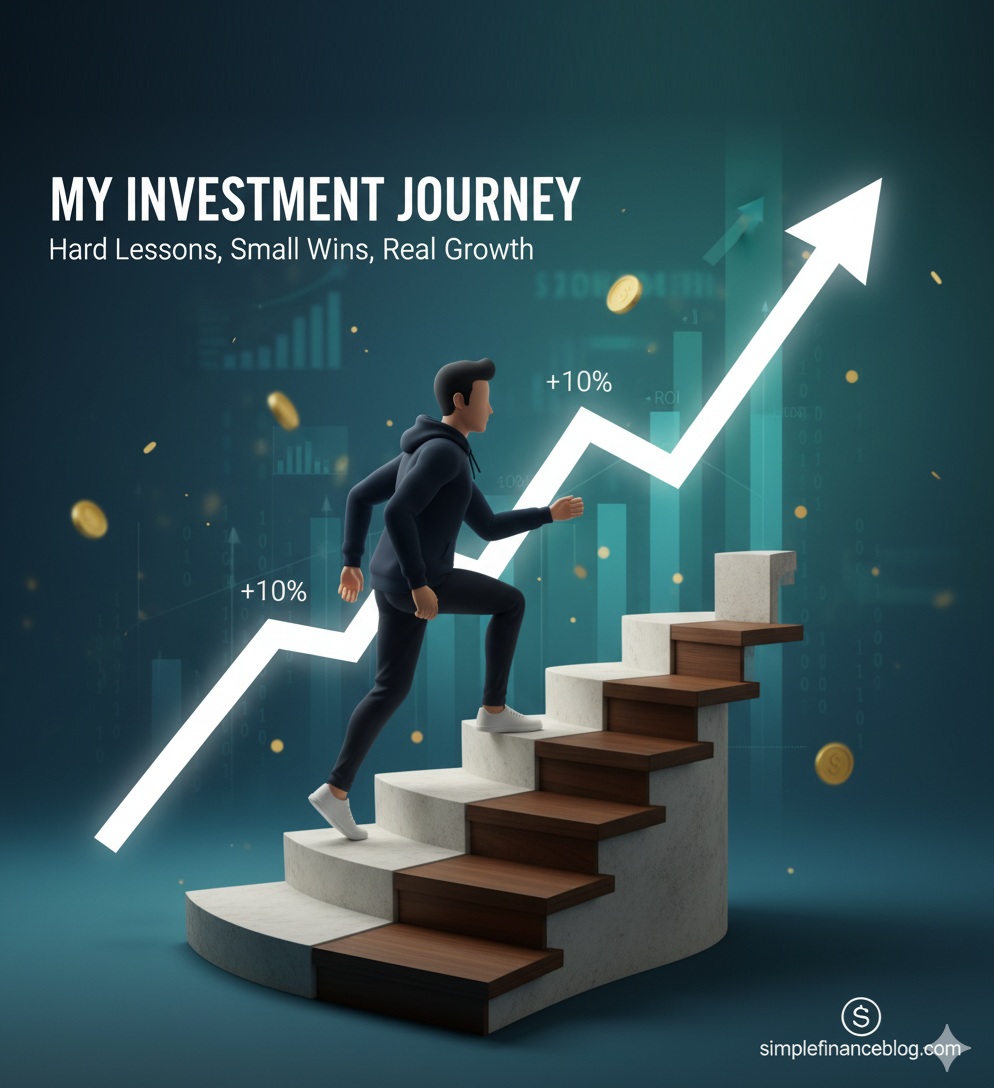By Cap Puckhaber, Reno, Nevada
My name is Cap Puckhaber, and if you’ve spent any time at all on my site, simplefinanceblog.com, you know I talk a lot about making money work for you. My investment journey hasn’t been straightforward; I’m not some Wall Street insider—I’m just a regular guy who spent a decade making every possible amateur mistake in the book before I finally figured out the simple, boring truth about building wealth. I’m sharing my whole investment journey, the good parts and the incredibly stupid parts. Honestly, I think it’ll save you a ton of time, stress, and, most importantly, money. We’re going to talk real numbers, real experiences, and the critical resources that finally set me straight.
My Journey as an Investor, Trader, and Blogger
I’ve been investing in the stock market for over 20 years and have been fortunate enough to have a 401(k) since I was 22 and RSU stocks since I was 30. I’ve always had a keen interest in business and finance and I’ve always been quite good with numbers. I think I have a good nose for identifying trends and doing my own due diligence. For the better part of 20 years, I subscribed to the set-it-and-forget-it method of putting my money in mutual funds. I didn’t look at it closely. However, as my work life started to slow down, my interest in my version of “day trading” increased. I started to get more involved in active trading. More involvement in trading doesn’t necessarily mean better returns, which is a costly lesson I learned over several years and through personal loss.
The Overlooked Power of Compounding Time
The greatest early mistake I made was underestimating the profound power of compound interest during those first two passive decades of investing. Compound interest means earning returns not just on your original investment, but also on the returns you’ve already accumulated over time. Albert Einstein reportedly called it the eighth wonder of the world for good reason; it’s the engine that truly drives long-term wealth creation. When I was 22, every single dollar I invested had 40 full years to compound. I often treated it like Monopoly money instead of a seed for a massive future forest of wealth. A foundational study by JPMorgan Asset Management (Reputable Source) consistently highlights that the majority of an investor’s total return over a 20-year period comes directly from compounded earnings, not just the initial capital contributions.
This fundamental knowledge is why the simplicity of a 401(k)’s initial automatic investment is so crucial for young investors. That early contribution, even a seemingly small one, is given the maximum possible amount of time to grow exponentially. This is an advantage that cannot be bought later. This early start matters far more than any subsequent stock-picking decision you’ll ever make down the line.
Current Reliance on Dividend Income
I now rely entirely on dividends as my source of income. I am actively prioritizing cash flow for my current living expenses. In most cases, the stocks that successfully pay these consistent dividends aren’t super sexy. They are definitely not typically known as traditional growth companies. I should be happy and grateful to receive these monthly dividend checks. I am currently not re-investing dividends, which is a key part of my current income strategy. However, the business, finance, and math side of me desperately wants to also see my investments grow significantly over time beyond just the dividend payout.
This growth does happen in some cases. There are certainly companies and funds that give a decent dividend, perhaps around 3% annually, while still growing at a healthy clip. However, their growth rate is decidedly not on par with the S&P 500 benchmark. I realized that for now, I absolutely cannot pay my bills on just a 3% yield. I have been much more aggressive with my income-generating investments, while simultaneously itching to grow my underlying asset base.
The Trade-Offs of Covered Call Funds
About 50% of my current investments are placed in various covered call funds for heightened income generation. For a complete and comprehensive deep dive into this complex strategy, you can read my post on covered calls explained income strategy. Combined, these various funds currently pay out a high yield closer to 7% annually, which is attractive for income. Minus the substantial dividends, these funds don’t really grow their principal value over the long term, which is the massive trade-off.
One of my largest funds has a five-year rate of return that is flat. One is only 15%, while the S&P is up 90% over the exact same five years for a critical comparison. The legitimate argument frequently posed by passive investors is, why not simply put it all in SPY and methodically sell shares to live on for income. That is a completely fair and mathematically sound argument that I have spent considerable time considering.
Psychologically, I truly don’t like the idea of selling my capital, even though the total value of the portfolio is ultimately higher and the strategy is superior. I may absolutely need to change my approach or at minimum decrease my reliance on these covered calls to less than 50%. I will then allocate much more money into growth-focused assets. This is the costly trade-off of selling future growth potential for present income, a financial reality many investors face as they transition into retirement or semi-retirement.
Growth, Volatility, and the Individual Stock Risk
Enough definitive material has been published about the S&P 500 or its big brother the Nasdaq, which tracks the top 100 technology stocks. You can also see my detailed blog on the S&P here: beginner’s guide to S&P 500 history, performance, and risk. Almost everyone knows the powerful, straightforward story of putting your money in the S&P. You’ll be completely fine 20, 30, or even 40 years from now, given the historical average return.
As I write this, the S&P is +15% YTD, but is also down −2% today, which sent the entire market into a temporary spiral as news of tariffs with China looms over global trade. The technology sector, more specifically the fast-growing AI companies like NVIDIA, AMD, and the Mag7 stocks, have clearly dominated all the headlines. They have made up nearly 90% of all S&P gains this year, showcasing massive concentration risk. If you’re passively holding SPY right now, you’re definitely doing just fine with your investments and beating most active managers.
The Allure of Concentrated Growth
However, where most of the spectacular money has been made is owning these individual AI stocks. NVDA is up +40% YTD and Oracle is up +80% YTD, dwarfing the index. If you trade individual stocks and got in “early” on these trends, then you are certainly extremely happy with your aggressive and timely investments. Growth investing is incredibly tricky for me personally. I have a tough time riding out these extreme waves of volatility. My mind truly freaks out when I see −5% days, which is entirely common for these more volatile tech stocks. However, +10% days are also common occurrences in the same volatile names.
Actionable Strategy: Dollar-Cost Averaging (DCA)
My personal aversion to these huge −5% days is exactly why the proven principle of Dollar-Cost Averaging (DCA) is so incredibly helpful. This is particularly true for new investors or those who struggle with emotional market timing. DCA is the consistent practice of investing a fixed dollar amount on a regular schedule. You do this regardless of what the share price is doing that day. This powerful strategy automatically forces you to buy more shares when prices are low and fewer shares when prices are high. It ultimately lowers your average cost per share over time. This crucial method removes the emotional guesswork of trying to time the market. This is an effort that even professional money managers fail at consistently over the long term.
The Psychological Benefit of DCA
A key academic study from Vanguard (Reputable Source), a firm known for its low-cost index philosophy, showed that while lump-sum investing mathematically outperforms DCA about two-thirds of the time in historical back-testing, the profound psychological benefit of DCA makes it the superior strategy. This benefit is specifically reducing anxiety and the paralyzing fear of market drops for the vast majority of individual investors. DCA ensures consistency and continuous participation in the market. These two factors overwhelmingly outweigh attempts at trying to perfectly time the market’s movements.
It effectively helps you avoid the severe emotional swings that commonly cause retail investors to sell low and buy high, which is the definition of poor investing. For a consistent investor, implementing an automated DCA schedule of weekly or monthly transfers into a broad index fund simplifies the entire process. You are no longer trying to catch +10% days or desperately avoid -5% days. You are simply accumulating shares over time at the market’s average price. This passive, deliberate approach aligns perfectly with the foundational Boglehead philosophy of passive, long-term wealth building, removing the need for daily involvement. It turns high volatility from a paralyzing source of panic into a beneficial opportunity to buy more shares cheaply. This fundamentally shifts your perspective.
The Options Trading Deep Dive and Risk Assessment
This challenging aspect of volatility leads directly into my next topic, which is options trading. This is an area where retail interest has exploded.
- Options trading is definitely not for the faint of heart, the novice investor, or those fundamentally afraid of large swings. People are making a ton of money trading options, and they are also losing it very quickly and quietly. If you follow the notorious Wall Street Bets Subreddit or the Race to $10M Subreddit, you see a lot of huge wins posted by various traders. However, people are far less likely to post their significant, devastating losses on these forums, skewing the perception of risk. If you’re new to options trading, as I was, terms like puts, calls, and shorts were all technical jargon I had heard before. I wasn’t 100% sure how it all worked, but I was super interested in learning the complex mechanics. You can gain a better understanding of these acute risks by viewing my blog on portfolio risk management here: definitive guide to portfolio investment risk management.
Why I Avoid Active Options Trading
Given that I am simply too averse to risk and significant swings, I have largely stayed away from active options trading. What I have found in my extensive research is that if you truly believe a stock will go up substantially, call options and put options purchased in large quantities can absolutely generate massive rates of return for your small capital outlay due to leverage. Conversely, if you strongly believe a stock or the overall market will go down substantially, then the same leveraged dynamic holds true for shorting or buying put options to generate profits.
On these specific subreddits, people post daily that they’ve purchased hundreds if not thousands of contracts. They buy or sell a fund to make a few dollars per share, seeking exponential returns. People have been successfully riding the wave on funds and stocks like NVDA this year. For example, a trader believes the stock will go up $10 by a certain expiration date, known as the options expiration date. They buy a high-strike call option $5 higher than the current price for a small premium, which might be $1.50 per share. If they are exactly right, just before it expires, they “cash in” on the $5 difference on thousands of shares with minimal capital outlay.
Options vs. Stock: Understanding Risk
The core difference between just buying and holding the stock and taking the entire $10 gain is pure risk and capital requirements. If the stock doesn’t hit the strike price, you “just” lose the premium paid, which can be tens of thousands of dollars. This is instead of needing to hold millions of dollars to buy thousands of shares of NVDA outright.
For me now, I need the income and am not confident in my analysis of options trading. Given the high volatility of the market, I am holding off, but I may potentially dip my toes in the water eventually. This type of trading feels more like gambling to me right now. However, if you’re going on the fundamental analysis of the company, then if you believe in a stock enough to own the stock or a fund that holds the stock, then it’s a calculated risk.
A reputable resource like the Chicago Board Options Exchange (CBOE) (Reputable Source) provides essential educational resources on the complex mechanics and high risks involved. Every interested investor should study this extensively before committing any capital.
The Strategy Debate: Diversification versus Growth
I listen to a lot of business and finance podcasts. Diversification is one of the most common, universally accepted themes discussed among financial experts. These influential millionaires often talk about holding crypto, real estate, gold, and growth stocks, among other tangible and digital assets. For the most part, I try to subscribe to this philosophy and truly believe in its long-term benefits.
However, one podcast guest also shared a simple truth: it’s simply easier to diversify when you are already rich and have multiple income streams. If your specific goal is to retire at a certain age with a substantial nest egg, owning gold and real estate, while both are relatively stable asset classes, will not grow at the same accelerated rate as the S&P 500 or Nasdaq over a typical 20-year horizon. Furthermore, the barrier to entry is significantly higher. This requires things like a substantial down payment on a house or the physical logistics of holding and safely storing physical gold.
The Opportunity Cost of Defensive Assets
Diversification also isn’t particularly sexy when the tech market is roaring ahead of everything else. As I mentioned, things like real estate or gold has historically not grown as fast as broad stock indexes. Although, as I write this, the price of gold has actually doubled recently, illustrating its role as a hedge. I’ve written about detailed risk and diversification principles here: market volatility hedge risk guide.
I tried to hold large, defensive positions in consumer staples, health care, and energy stocks. They barely returned anything over a long period, causing massive opportunity cost. While the Nasdaq was growing at double-digit percentages, the Dow Jones Industrial Average (which has more of these older, defensive types of companies) was returning single digits or was actually down in some quarters. I think the key takeaway here is that it’s good practice to diversify by picking industries that are stable but still have significant room for secular growth and may pay a dividend, like mining, energy, and pharma. However, if you are truly striving to build a large nest egg from the ground up, then growth stocks, held in a diversified index, are still the most reliable way to go.
A Deeper Look at Tax-Advantaged Accounts and Asset Location
The critical concept of diversification must extend beyond just asset types. It must strategically include the tax status of your investment accounts. A crucial aspect of sophisticated financial planning is fully utilizing tax-advantaged accounts—like the 401(k) and the Roth IRA—before allocating capital into a standard taxable brokerage account. This strategic placement is often called Asset Location.
- Tax-Advantaged Accounts: These powerful accounts protect your money from annual taxation, either when you put it in (Traditional 401(k)) or when you take it out later (Roth IRA). The IRS (Reputable Source) provides explicit guidelines and contribution limits each year. You should maximize these before contributing to taxable accounts. The IRS publishes official limits and rules for contribution eligibility and withdrawals, which are absolutely essential for every investor to follow for compliance. The enormous benefit here is the massive advantage of letting your money compound completely without being taxed annually on dividends or capital gains.
- Taxable Accounts: While these standard accounts offer maximum liquidity and flexibility, every dividend payment or profit from selling an asset held for less than a year is subject to taxation. This is taxed either as ordinary income or at the capital gains rate. This annual taxation creates a constant drag on your compounding. You are forced to pay taxes on your growth every single year, diminishing the power of compounding. This is why it is highly recommended by experts to place high-growth, high-turnover investments in your tax-advantaged accounts, saving the less-tax-efficient assets for your standard brokerage.
Maximizing Net Return After Tax
This entire concept of Asset Location is a sophisticated form of diversification that maximizes your net return after taxes are accounted for. It’s not just about what you own, but where you own it. For example, a high-dividend fund, like my covered calls, is often best held in a 401(k) or IRA. This is done to strategically shield that high-income stream from annual taxation. Conversely, highly tax-efficient index funds that pay very little in dividends and have low turnover are perfectly acceptable in a taxable brokerage. By optimizing for tax efficiency, you effectively add basis points to your annual return without taking on any additional risk. This is a key advanced strategy.
The Meme Stock Trap: Understanding Herd Mentality
This term has gained considerable popularity over the past 5-6 years. It represents a new and highly volatile phenomenon in the retail trading landscape driven by social media. Gamestop may be the most well known meme stock that captured the media’s attention with its incredible volatility. Recently companies like Open Door have also gained significant notoriety through forum activity. What I’ve consistently found is that various subreddits are always abuzz when it comes to meme stocks. People constantly share their huge holdings, their large gains, and their next “picks.” I initially thought this was a gold mine of information. I quickly found out that it’s entirely buyer beware.
People are almost always putting information out there to benefit only themselves and their existing positions. Timing is absolutely key in this market. If they are pumping something waiting to dump it, then they are going to loudly tout it and get out before you can act and profit. So, this is an area I tried once and failed miserably, losing 10% of my capital in a matter of a few hours due to a sudden crash.
If you are extremely dedicated to scouring Reddit, diligent with your limits on what price to buy/sell, and are closely following trends like volume, then you could potentially get lucky and see 100% gains in a single day. Unfortunately, you could also easily lose 90% in a single day too, which is far more common, making it functionally equivalent to outright gambling.
The Securities and Exchange Commission (SEC) (Reputable Source) has issued formal investor alerts warning against the dangers of “pump and dump” schemes often promoted on social media platforms. They emphasize the importance of independent research over herd recommendations.
Lessons Learned and a Need for Discipline
I’ve learned a few important things over the past few years. I sincerely hope I can learn from these expensive observations and mistakes. In no particular order, here are my biggest takeaways, which have fundamentally changed my approach to money and risk management:
The Psychological Cost of Active Trading
The truth is that active, day-to-day trading carries a massive psychological cost that is rarely discussed on financial forums like Reddit. The anxiety of constantly monitoring market dips and news events is a significant, measurable mental drain that affects overall well-being.
Daily Routines
- When I wake up in the morning and see things are down 1%, my immediate gut reaction is to sell it, capture what I’ve gained, and then buy it back at a lower price, which is a classic but often flawed impulse. This strategy can theoretically work sometimes. However, it requires a lot of constant watching and attention, which inevitably leads to significant anxiety and stress. For this selling-and-buying-back strategy to work, it requires the stock to go down and subsequently go back up for you to actually capture gains. You must perfectly execute both trades. It also seriously doesn’t account for the market eventually bouncing back later in the day, which often happens after an initial panic. I’ve personally sold when something was down 2%, and by the end of the day it was actually up 1%. This means I lost money selling when it was down, didn’t capture the eventual gain when it went up, and my average price per share went up overall—a triple mistake.
The Importance of Research
- Research from highly respected behavioral finance experts, such as those at Morningstar (Reputable Source), continually shows that individual investors who trade frequently often severely lag passive benchmarks due to this exact behavior—selling low and buying high out of fear or greed. The emotional urge to act on volatility is the single biggest enemy of long-term returns and portfolio performance. The vast majority of investors would be demonstrably better served by automating their investments and literally forgetting their password for a year or more. The only way to truly defeat market volatility is by being a long-term, disciplined holder who ignores the noise.
Stick with the Fundamentals (The Moat Concept)
If you truly believe in a company or an investment, then you must stick with your plan through short-term fluctuations. Do your initial research thoroughly. Believe in the core fundamentals of what a company is doing and the technological space they are operating within. Look at critical things like long-term growth potential, profitability, guidance, moats, potential partnerships, government contracts, and what reputable “analysts” are saying about the company’s prospects.
If you fundamentally believe in the company, then you must stick to the first rule and have absolutely no knee-jerk reactions when the price fluctuates. I lost out twice this year on Micron and Marvell when I was up and the stock dipped. I sold the dip, and since then both have skyrocketed. When it dipped initially, nothing about the company’s fundamentals changed. The fundamentals were still great, and what they were building and the space they were in were still great.
The key to this conviction is finding the company’s moat—its sustainable competitive advantage, a concept popularized by legendary investor Warren Buffett. Does the company have a massive, unassailable brand (Apple), high switching costs for customers (Microsoft), or regulatory protection (Pharma)? When volatility hits, if the moat is intact, you should hold or even buy more shares. If the moat is breached (e.g., a competitor releases superior tech or a patent expires), then the fundamentals have truly changed, and you should rationally consider selling. This crucial distinction is necessary for making rational, long-term decisions versus emotional ones.
Be Critical of Social Media and Information Overload
You must be extremely careful with what you read on Reddit and similar forums. I think only about 20% of the information on there is genuinely useful or actionable for a serious investor. I found some great stocks and some great pieces of information there. However, 80% of the information is simply people trying to pump their own holdings for personal gain and hype. You need to verify every claim. Do your own extensive research, cross-referencing against verified sources like SEC filings (Reputable Source) or reputable financial news outlets such as The Wall Street Journal. Relying solely on anonymous forum posts for investment decisions is a a guaranteed path to financial heartbreak and loss.
Choose a Strategy and Commit
You must clearly decide if you’re investing for aggressive growth, steady income, diversification, or some specific mix of these goals before you start trading. Pick a coherent mix or a defined strategy, and then you must stick with it consistently through all market cycles. Flipping back and forth and constantly messing with your asset mix will only cause a lot of headaches and significant financial underperformance. This is due to constantly chasing what’s currently hot. You will ultimately end up chasing conflicting goals. At best you will only break even, which is what I essentially did this year due to poor discipline. At worst, you will be significantly down, when you could have just picked SPY and left it alone for substantial, easy growth. The single biggest risk is not having a clear, written plan at all.
My Simple Path: The Actionable Four-Step Strategy
My entire journey from being an enthusiastic but ultimately naive stock-picker using 401(k) funds to becoming a quiet, patient, total-market index investor was a slow and financially expensive shift. It took me a significant number of years to realize that the most successful, most profitable investing strategy is also reliably the most boring one imaginable. I had to shift my focus entirely from chasing a high 7% income, which consistently cost me my valuable capital appreciation. My focus is now a strategic one: maximizing total return through simple, low-cost index funds. That powerful shift means accepting the market’s 10% historical return. It prioritizes my time and consistency over trying to be clever or trying to time the market. That profound psychological and intellectual shift in mentality is the most important component of this entire story.
You can certainly take all the confusing jargon, all the intense market commentary, and all the hot tips on Reddit. You can reliably distill it down to a few incredibly simple, powerful, and actionable steps that will lead to success.
Step 1: Fund the Employer Match (Free Money)
You absolutely must get the free money in your 401(k). That is the highest guaranteed return you’ll ever see in the entire market. This foundational step is non-negotiable for building long-term wealth. It is an immediate 50% to 100% return on your contribution with zero risk. Fund the match first before any other investment. You should check the official Department of Labor (Reputable Source) website for retirement plan resources. This is to fully understand your employer’s obligations and vesting schedules.
Step 2: Max the Roth (Tax-Free Growth Engine)
You should prioritize the massive tax-free growth of your Roth IRA. This is to create a powerful, untouchable bucket of wealth for the future of your retirement. The Roth IRA allows your earnings to compound completely tax-free and be withdrawn tax-free in retirement. This offers a massive advantage over taxable accounts. Maximize your annual contribution limit for the Roth IRA after securing your employer match.
Step 3: Invest the Rest (The Liquid Growth Pool)
You need to consistently put all remaining savings into a broadly diversified, low-cost index fund. Use a fund like a BlackRock or Fidelity total-market ETF. This is for simple, broad exposure to the global economy. This strategy ensures you capture the entire market’s performance rather than being dependent on individual stock performance. The goal is to maximize total return while keeping expenses low, even if you do incur capital gains tax upon sale. This is where the core of your wealth-building should occur, using the DCA principle.
Step 4: Automate and Forget (The Emotional Shield)
You must set up all your automatic contributions. Then, actively stop checking the daily market news. Emotional decisions are always financially costly over the long term. Automation removes emotion from your investment process, ensuring you buy both when the market is up and when it is down. This disciplined approach is the most crucial part of long-term success.
The true secret to building sustainable wealth isn’t about predicting the next bull run or successfully dodging the next recession. It’s simply about making sure you’re in the market consistently. This ensures that you reliably capture all the days of growth, not just the random ones you happen to guess correctly. This simple, boring approach really works, and you can start today.
Cap Puckhaber, simplefinanceblog.com
Investing Blog for Beginners
Hosted by Cap Puckhaber of Black Diamond Marketing Solutions, this investing blog offers daily articles on investing, savings, bonds, interest rates, mortgages, and more.



About the Founder / Author
Cap Puckhaber is a seasoned marketing strategist and finance writer, based in Reno, Nevada with over 20 years of experience investing, marketing and helping small businesses grow.
He offers expert advice on how to save for retirement, how to use a retirement calculator and the difference between T-Bills and CDs.
Cap Puckhaber shares actionable insights on how to promote your business locally for free and on trending platforms like X.
He shares his personal investment journey, how to use trade volume to predict breakouts, and his take on covered call strategies.

Follow Cap Puckhaber Online
Connect with Cap Puckhaber on Facebook
See Real-Time Thoughts on X
Read In-Depth Articles on Medium
Subscribe to Cap Puckhaber’s Substack Newsletter
Follow Cap Puckhaber’s Company Page on LinkedIn
View Our Agency Profile on DesignRush
See Cap Puckhaber’s Agency on Agency Spotter
Explore Technical Projects on GitHub
See Cap Puckhaber’s Creative Portfolio on Behance
Learn more about my company on Crunchbase
Join Cap Puckhaber’s Conversation on BlueSky
Follow My Updates on Mastodon

Backpacker, Marketer, Investor, Blogger, Husband, Dog-Dad, Golfer, Snowboarder
Cap Puckhaber is a marketing strategist, finance writer, and outdoor enthusiast from Reno, Nevada. He writes across CapPuckhaber.com, TheHikingAdventures.com, SimpleFinanceBlog.com, and BlackDiamondMarketingSolutions.com.
Follow him for honest, real-world advice backed by 20+ years of experience.


